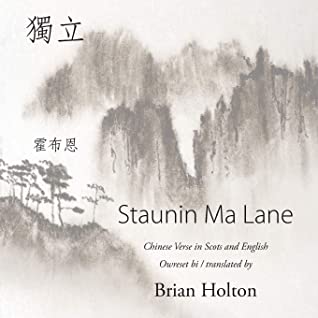144 pages
Scots, English language
Published Jan. 10, 2016 by Shearsman Books.

144 pages
Scots, English language
Published Jan. 10, 2016 by Shearsman Books.
Staunin Ma Lane isn’t intended to be a comprehensive tour of classical Chinese poetry, though it does contain specimens of many of the major genres and styles, and it may serve as a first primer. Note that the poetry is in the Scots: the English versions are there to help the non-Scots speaker. It has been my aim to make poems in Scots: if you expect to find dictionary definitions of Chinese words in my translations, you will be disappointed. That sort of drably mechanical ‘accuracy’ does not make poetry, and a poem that doesn’t move the reader is like a joke that isn’t funny. In the translation of poetry, there are many, many more ways of being wrong than of being right, and I do not claim that my versions are in any way definitive or better than anyone else’s: I do, however, want to say to the reader, …
Staunin Ma Lane isn’t intended to be a comprehensive tour of classical Chinese poetry, though it does contain specimens of many of the major genres and styles, and it may serve as a first primer. Note that the poetry is in the Scots: the English versions are there to help the non-Scots speaker. It has been my aim to make poems in Scots: if you expect to find dictionary definitions of Chinese words in my translations, you will be disappointed. That sort of drably mechanical ‘accuracy’ does not make poetry, and a poem that doesn’t move the reader is like a joke that isn’t funny. In the translation of poetry, there are many, many more ways of being wrong than of being right, and I do not claim that my versions are in any way definitive or better than anyone else’s: I do, however, want to say to the reader, “Deek whit the Mither Tongue can dae: gin it can dae this, whit’ll it no can dae?” (Look what our mother tongue can do: if it can do this, what will it not do?), and I would urge readers inclined toward translation to do it for themselves.